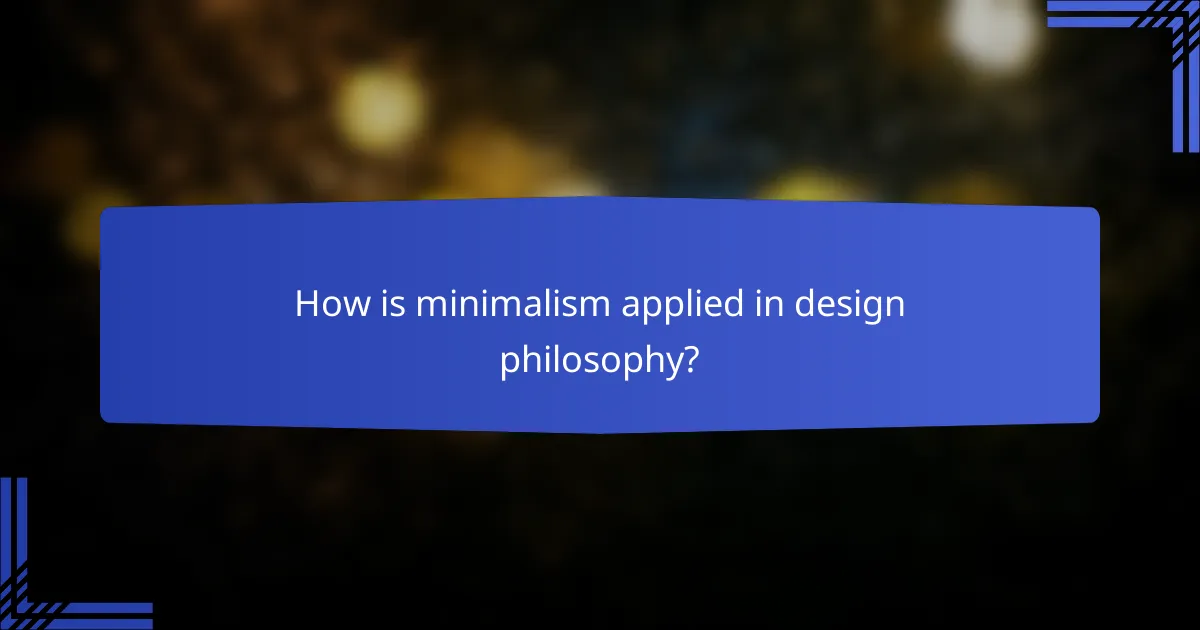Minimalism emerges as a reaction against expressionism, prioritizing simplicity and clarity over emotional depth. By reducing elements to their essential forms, this design philosophy aims to create a clean and uncluttered aesthetic that emphasizes functionality and effective use of space.

How does minimalism react against expressionism?
Minimalism serves as a counterpoint to expressionism by emphasizing simplicity and clarity over emotional intensity. While expressionism seeks to convey deep feelings and subjective experiences, minimalism focuses on reducing elements to their essential forms, stripping away excess to reveal the core of an idea or design.
Contrast in artistic intent
The artistic intent of minimalism starkly contrasts with that of expressionism. Expressionism aims to evoke strong emotions and personal interpretations, often using bold colors and dynamic forms. In contrast, minimalism prioritizes a restrained aesthetic, seeking to communicate through simplicity and the absence of distraction.
This difference in intent leads to distinct artistic outcomes. Minimalist works often invite viewers to engage with the piece on a conceptual level, while expressionist works demand emotional responses, creating a more visceral experience.
Focus on form over emotion
Minimalism emphasizes form and structure rather than emotional expression. This design philosophy values clean lines, geometric shapes, and a limited color palette, allowing the viewer to appreciate the beauty of simplicity. For example, a minimalist painting may consist of a single color field, inviting contemplation rather than emotional turmoil.
In contrast, expressionist art often features chaotic compositions and vibrant colors to express complex feelings. The minimalist approach encourages viewers to find meaning in the absence of overt emotional cues, focusing instead on the purity of the form itself.
Historical context of minimalism
Minimalism emerged in the mid-20th century as a reaction to the emotional excesses of expressionism and other art movements. Influenced by developments in modernism and post-war sentiments, artists sought to create works that were stripped down to their essentials. This movement gained traction in the 1960s, with figures like Donald Judd and Agnes Martin leading the way.
The historical context of minimalism reflects broader cultural shifts towards simplicity and functionality, paralleling trends in architecture and design. As society began to embrace efficiency and clarity, minimalist art resonated with these ideals, establishing a lasting legacy in contemporary art and design practices.

What are the core principles of minimalism?
The core principles of minimalism center around simplicity, functionality, and the effective use of space. This design philosophy emphasizes stripping away the unnecessary to focus on the essential elements, creating a clean and uncluttered aesthetic.
Simplicity in design
Simplicity in design is about creating visuals that are straightforward and easy to understand. This often involves using a limited color palette, basic geometric shapes, and clean lines. For example, a minimalist website may feature a single-column layout with ample white space, allowing users to focus on the content without distractions.
When implementing simplicity, aim for a design that communicates its message clearly. Avoid overly complex graphics or intricate patterns that can confuse the viewer. A good rule of thumb is to ask yourself if each element serves a purpose; if not, consider removing it.
Functionality over decoration
Minimalism prioritizes functionality over decorative elements, ensuring that every component serves a practical purpose. This means that furniture, products, or digital interfaces are designed to be useful first, with aesthetics being a secondary consideration. For instance, a minimalist chair may have a simple form but is ergonomically designed for comfort.
To embrace this principle, evaluate your designs by asking if they enhance user experience. Avoid adding decorative features that do not contribute to the overall function. This approach not only improves usability but also creates a more cohesive and appealing design.
Use of negative space
The use of negative space, or white space, is crucial in minimalist design as it helps to create balance and focus. By intentionally leaving areas of a design empty, you can draw attention to the essential elements and improve readability. For example, a business card with ample negative space around the text can make the information stand out more effectively.
When incorporating negative space, consider the layout and how elements interact with each other. Aim for a harmonious distribution of space that guides the viewer’s eye naturally. Avoid overcrowding your design, as this can detract from the minimalist aesthetic and overwhelm the audience.

How is minimalism applied in design philosophy?
Minimalism in design philosophy emphasizes simplicity and functionality, stripping away unnecessary elements to focus on the essential. This approach fosters clarity and efficiency, making designs more user-friendly and aesthetically pleasing.
Interior design examples
In interior design, minimalism often manifests through open spaces, neutral color palettes, and functional furniture. For instance, a minimalist living room may feature a simple sofa, a single coffee table, and unobtrusive decor, allowing for a calm and uncluttered environment.
Key elements to consider include the use of natural light and the strategic placement of furniture to enhance flow. Avoid excessive decoration; instead, choose a few statement pieces that resonate with the overall design theme.
Graphic design applications
Minimalism in graphic design prioritizes clean lines, ample white space, and limited color schemes. This approach helps convey messages clearly and effectively, making it easier for viewers to focus on the content without distractions.
Effective minimalist graphic design often employs typography as a central element, using bold fonts and simple layouts. Designers should aim for a balance between aesthetics and functionality, ensuring that every element serves a purpose.
Product design trends
In product design, minimalism translates to sleek, user-friendly products that prioritize usability over unnecessary features. Examples include smartphones with streamlined interfaces and furniture that combines form and function without excess embellishments.
When designing products, consider the user experience by simplifying controls and reducing clutter. Focus on high-quality materials and craftsmanship to enhance the product’s appeal while maintaining a minimalist ethos.

What are the benefits of adopting minimalism?
Adopting minimalism offers numerous benefits, including reduced stress, enhanced focus, and cost-effectiveness in design. By simplifying your environment and choices, you can create a more peaceful and productive lifestyle.
Reduced stress and clutter
Minimalism significantly reduces stress by eliminating physical and mental clutter. A tidy, simplified space can lead to a calmer mindset, allowing you to focus on what truly matters.
To achieve this, start by decluttering your living or working space. Aim to keep only items that serve a purpose or bring you joy. Regularly reassess your belongings to maintain a clutter-free environment.
Enhanced focus and productivity
Minimalism enhances focus and productivity by removing distractions. A streamlined environment allows you to concentrate better on tasks, leading to improved efficiency and creativity.
Consider adopting a minimalist workspace. Limit the number of items on your desk to essentials, and organize your digital files to reduce visual clutter. This can help you stay on task and accomplish more in less time.
Cost-effectiveness in design
Minimalism promotes cost-effectiveness in design by prioritizing quality over quantity. By choosing fewer, high-quality items, you can save money in the long run and reduce waste.
When designing a minimalist space, focus on versatile pieces that serve multiple functions. For example, a sofa bed can provide seating and sleeping options without taking up extra space. This approach not only saves money but also creates a more functional environment.

What are the challenges of minimalism?
Minimalism faces several challenges, including misinterpretation of its simplicity, the need to balance aesthetics with functionality, and the potential for designs to become bland. These challenges require careful consideration to ensure that minimalism achieves its intended purpose without sacrificing quality or appeal.
Misinterpretation of simplicity
One of the main challenges of minimalism is the frequent misinterpretation of simplicity as a lack of effort or creativity. Some may perceive minimalist designs as overly basic or unfinished, which can undermine the thoughtful intention behind them. It’s essential to communicate that minimalism is about intentionality and clarity, not just stripping away elements.
To avoid this pitfall, designers should focus on the purpose of each element in their work. Every component should serve a function, contributing to the overall experience rather than merely existing for aesthetic reasons. This approach helps clarify that minimalism is a deliberate choice rather than an absence of detail.
Balancing aesthetics with functionality
Another challenge is achieving a balance between aesthetics and functionality. Minimalist designs must not only look appealing but also serve their intended purpose effectively. Striking this balance can be difficult, as overly simplistic designs may fail to meet user needs or expectations.
To address this challenge, designers should prioritize user experience while maintaining a clean aesthetic. Conducting user testing can provide insights into how well a minimalist design performs in real-world scenarios. This feedback can guide adjustments that enhance both the visual appeal and functionality of the design.
Potential for blandness
The risk of blandness is a significant concern in minimalist design. When too many elements are removed, the result can be a visually uninteresting or uninspiring space. This challenge emphasizes the importance of thoughtful selection and arrangement of elements to maintain engagement.
To combat blandness, designers can incorporate unique textures, colors, or materials that add depth without cluttering the design. Using contrast effectively can also create visual interest while adhering to minimalist principles. Ultimately, the goal is to create a space that feels both simple and inviting, avoiding the trap of monotony.

What criteria should be considered when implementing minimalism?
When implementing minimalism, focus on simplicity, functionality, and the essential needs of users. Key criteria include understanding user needs, assessing available space and materials, and evaluating long-term sustainability.
Understanding user needs
Identifying user needs is crucial for effective minimalism. Engage with users to determine their core requirements and preferences, ensuring that the design serves a practical purpose without unnecessary embellishments.
Consider conducting surveys or interviews to gather insights. This can help prioritize features that enhance usability while eliminating those that do not contribute to the overall experience.
Assessing space and materials
Evaluating the physical space and materials is essential for a minimalist approach. Analyze the layout to maximize functionality while maintaining an uncluttered environment. Utilize versatile materials that are durable and easy to maintain.
For example, opting for multi-functional furniture can save space and reduce the need for excess items. Choose materials that are sustainable and align with the minimalist philosophy, such as bamboo or recycled metals.
Evaluating long-term sustainability
Long-term sustainability should be a priority when implementing minimalism. Assess the environmental impact of materials and processes used in the design. Aim for solutions that minimize waste and promote energy efficiency.
Consider adopting practices such as using renewable resources and designing for longevity. This not only supports the minimalist ethos but also contributes to a healthier planet and potentially lower costs over time.
